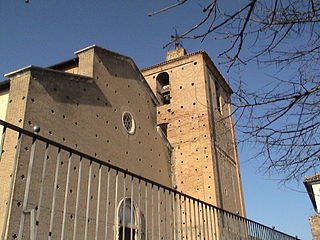
Abruzzo, historically known as Abruzzi, is a region of Southern Italy with an area of 10,763 square km and a population of 1.3 million. It is divided into four provinces: L'Aquila, Teramo, Pescara, and Chieti. Its western border lies 80 km (50 mi) east of Rome. Abruzzo borders the region of Marche to the north, Lazio to the west and north-west, Molise to the south and the Adriatic Sea to the east. Geographically, Abruzzo is divided into a mountainous area in the west, which includes the highest massifs of the Apennines, such as the Gran Sasso d'Italia and the Maiella, and a coastal area in the east with beaches on the Adriatic Sea.
The Marrucini were an Italic tribe that occupied a small strip of territory around the ancient Teate, on the east coast of Abruzzo, Italy, limited by the Aterno and Foro Rivers. Other Marrucinian centers included Ceio, Iterpromium, Civitas Danzica (Rapino), and the port of Aternum (Pescara), shared with the Vestini.

Pescara is the capital city of the Province of Pescara, in the Abruzzo region of Italy. It is the most populated city in Abruzzo, with 118,657 residents. Located on the Adriatic coast at the mouth of the Aterno-Pescara River, the present-day municipality was formed in 1927 joining the municipalities of the old Pescara fortress, the part of the city to the south of the river, and Castellamare Adriatico, the part of the city to the north of the river. The surrounding area was formed into the province of Pescara.

The province of L'Aquila is the largest, most mountainous and least densely populated province of the Abruzzo region of Central Italy. It comprises about half the landmass of Abruzzo and occupies the western part of the region. It has borders with the provinces of Teramo to the north, Pescara and Chieti to the east, Isernia to the south and Frosinone, Rome and Rieti to the west. Its capital is the city of L'Aquila.

The province of Chieti is a province in the Abruzzo region of Italy. Its provincial capital is the city Chieti, which has a population of 50,770 inhabitants. The province has a total population of 387,649 inhabitants as of 2017 and spans an area of 2,599.58 square kilometres (1,003.70 sq mi). It is divided into 104 comuni (comune) and the provincial president is Mario Pupillo.

The province of Pescara is a province in the Abruzzo region of Italy. Its provincial capital is the city Pescara, which has a population of 119,483 inhabitants. As of 2017, it has a total population of 319,936 inhabitants over an area of 1,230.33 square kilometres (475.03 sq mi). The provincial president is Antonio Zaffiri and the province contains 46 comuni.

Alba Fucens was an ancient Italic town located at 1,000 m (3,300 ft) elevation at the base of Monte Velino, approximately 6.5 km (4.0 mi) north of Avezzano, Abruzzo, central Italy. Its ruins can be found in the comune of Massa d'Albe.

Chieti is a city and comune (municipality) in Southern Italy, 200 kilometres east of Rome. It is the capital of the province of Chieti, in the Abruzzo region.

Via Tiburtina is an ancient road in Italy leading east-northeast from Rome to Tivoli and then, with the via Valeria, on to Pescara.

Pyrgi was originally an ancient Etruscan town and port in Latium, central Italy, to the north-west of Caere. Its location is now occupied by the borough of Santa Severa. It is notable for the discovery here of the gold tablets, an exceptional epigraphic document with rare texts in Phoenician and Etruscan languages, and also the exceptional terracotta pediment statues from the temple.

D'Annunzio University is a public research university located in Chieti and Pescara, neighbouring cities in the region of Abruzzo, Italy. Established in 1960 as a higher education institute and named after writer and poet Gabriele D'Annunzio, it was officially recognised as an independent university in 1965 by Minister Luigi Gui.
San Giovanni Teatino is a comune and town in the Province of Chieti in the Abruzzo region of Italy. Until 1894 this comune was known as Forcabobolina. Situated on a hill overlooking the valley of the river Pescara (Aterno-Pescara), in recent years the place has undergone an industrial development, especially in the area of Sambuceto. Abruzzo Airport is also located in a portion of the municipal territory, close to the border with Pescara. In fact, the municipality is virtually divided into two, San Giovanni Teatino (Alto), which is the historic village on the hill, and the aforementioned Sambuceto, an ever-growing urban settlement, home to a large shopping area and an important industrialized area.<>

The Abbey of San Giovanni in Venere is a monastery complex in the comune of Fossacesia, in Abruzzo, central Italy. it is located on a hill facing the Adriatic Sea, at 107 m over the sea level.

The Archdiocese of Pescara-Penne is a Latin diocese of the Catholic Church on the east coast in central Italy.

Pescara Cathedral is a Roman Catholic cathedral in the Via D'Annunzio in the city of Pescara. The cathedral, dedicated to Saint Cetteus, patron saint of Pescara, has been the seat of the Archbishop of Pescara-Penne since the creation of the archdiocese in 1982. The present Romanesque Revival building, originally called the Tempio della Conciliazione, was constructed in the 1930s, replacing the medieval church of San Cetteo.
The Leonardo da Vinci University, often simply abbreviated as "Unidav" is a private university founded in 2004 in Torrevecchia Teatina, Italy. It was created and promoted by the D'Annunzio University of Chieti–Pescara.

Penne Cathedral is a Roman Catholic cathedral dedicated to Saint Maximus in Penne, Abruzzo, Italy.

Torre e Palazzo de Felice is a fortified baroque palace built into a medieval castle in Rosciano, Province of Pescara (Abruzzo). Built on the north bank of the River Pescara, it is an ancestral home of the de Felice family.
Lehun, also known as al-Lahun or Khirbet Lahun, is an archaeological site in Madaba Governorate, Jordan.















